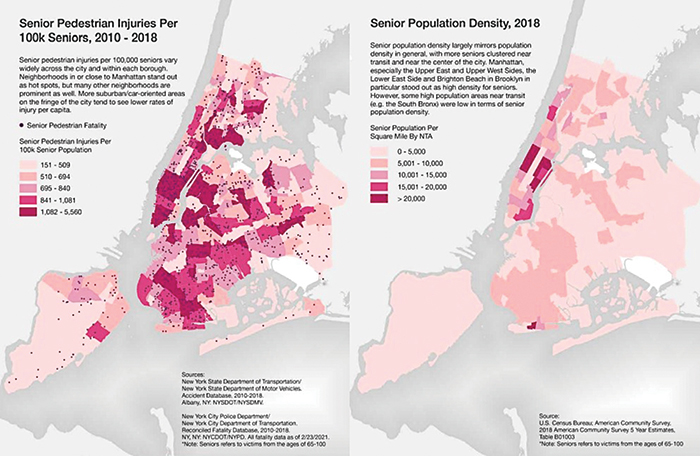Courtesy of DOT
By Forum Staff
The City Department of Transportation has released the Pedestrian Safety and Older New Yorkers Study, as well as a series of initiatives that are part of a larger investment to improve overall pedestrian safety at intersections, DOT Commissioner Ydanis Rodriguez announced on Monday.
The study analyzes key factors contributing to crashes amongst older New Yorkers and put forth commitments to Vision Zero treatments like turn calming, which lower senior pedestrian deaths and serious injuries by up to 60 percent. The report also identified new Senior Pedestrian Zones to guide future engineering, enforcement and education. DOT will install turn calming treatments at 50 intersections annually and drastically expand pedestrian head-starts (known as Leading Pedestrian Intervals – or LPIs) installations by 2024 within those same zones, along with a host of other commitments to keep older pedestrians safe.
The population of New Yorkers aged 65 and older is growing, currently making up about 15 percent of New York City’s population, but over 45 percent of pedestrian fatalities. Older adult pedestrians also have worse outcomes if in a crash than compared to other age groups, and have more difficulty scanning different directions of traffic. Older adult pedestrian fatalities are more likely to occur close to home and in the middle of the day.
Left turn failure to yield crashes are nearly twice as deadly for older adults than for younger adults, and account for 35 percent of older adult pedestrian fatalities.
Senior Pedestrian Zones identified in the study will guide future engineering, enforcement and education. They cover the locations of approximately 30 percent of citywide older adult fatalities and severe injuries but only 13 percent of the city’s square mileage. DOT’s data driven commitments include:
- Extending LPI crossing times during mid-day in Senior Pedestrian Zones and at new LPI locations by the end of 2024
- Adding LPIs at all feasible intersections on Priority Corridors in Senior Pedestrian Zones by the end of 2024
- Creating Senior Turn Calming initiative and installing treatments at 50 Older Adult targeted intersections annually
- Implementing ten or more Senior Street Improvement Projects annually
- Targeting Raised Crosswalks to older pedestrians and safety improvements near and at bus stop locations
- Targeting safety improvements to bus stop locations under elevated trains
- Targeting Older Adult Education and Outreach to Senior Pedestrian Zones
Other key findings of the study include:
- Road diets, bicycle lanes, pedestrian islands, sidewalk expansions, turn calming and leading pedestrian intervals (LPIs) all deliver impressive injury reductions for older adults. LPIs and turn calming treatments reduce older adult pedestrian deaths and serious injuries by 40-60 percent
- Crash patterns suggest that older pedestrians use the street very similarly to younger adults
- More older adults are injured or killed while riding their bike than by being struck by a cyclist
- Asians are overrepresented in older adult pedestrian fatalities. This is likely due to older Asian populations being concentrated in denser parts of the city (Manhattan Chinatown, Sunset Park, Flushing, Jackson Heights) where walking rates are higher and car ownership is lower, leading to increased exposure to traffic.
Intersections are the leading site of pedestrian injuries and fatalities, the report noted. This January, Mayor Eric Adams, Rodriguez, and City Police Commissioner Keechant Sewell committed to make safety design improvements to 1,000 intersections with improved traffic signals, raised crosswalks, and other expanded pedestrian space and visibility measures.

